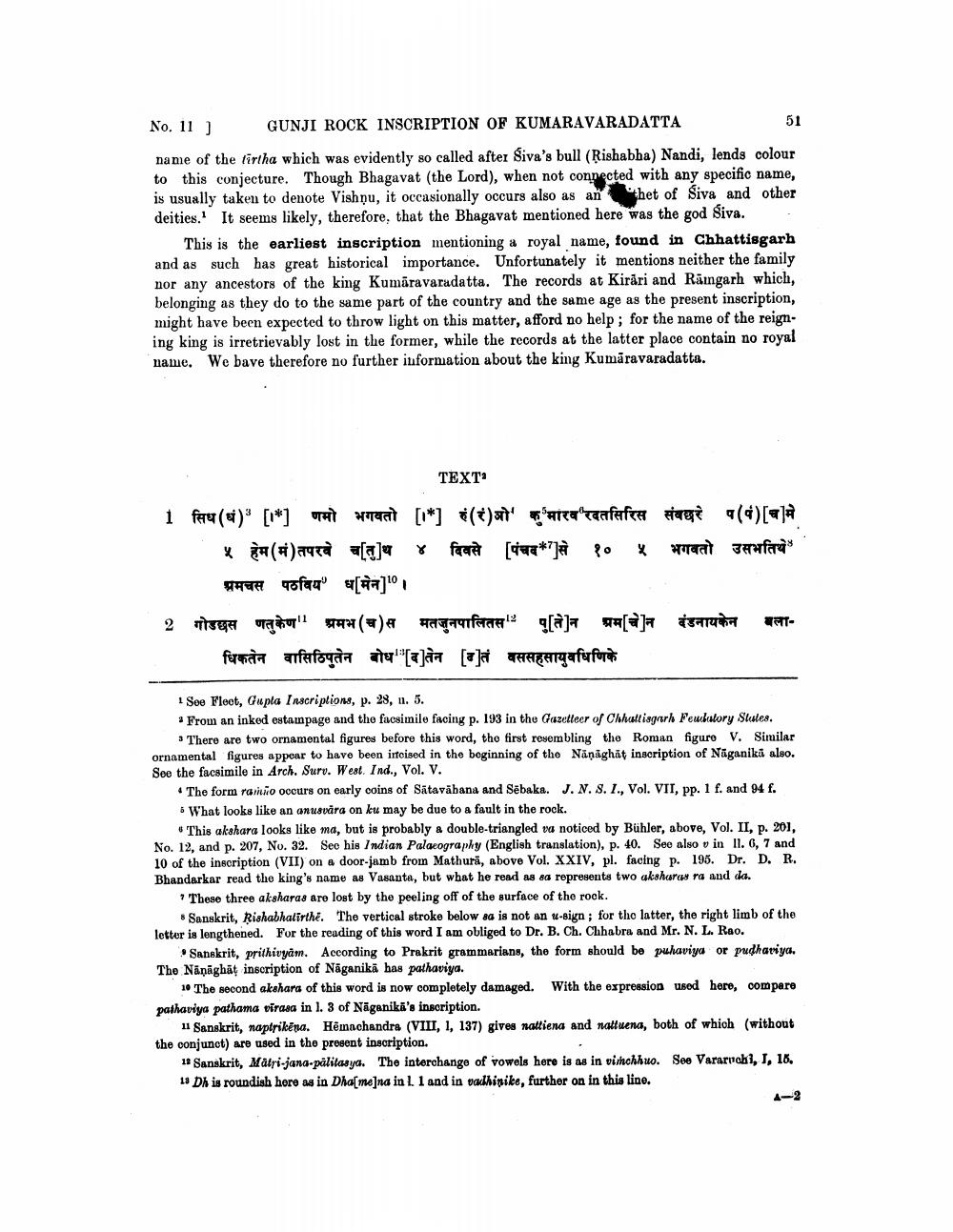________________
No. 11 ) GUNJI ROCK INSCRIPTION OF KUMARAVARADATTA
51 name of the tirtha which was evidently so called after Siva's bull (Rishabha) Nandi, lends colour to this conjecture. Though Bhagavat (the Lord), when not connected with any specific name, is usually taken to denote Vishnu, it occasionally occurs also as an het of Siva and other deities. It seems likely, therefore, that the Bhagavat mentioned here was the god siva. .
This is the earliest inscription mentioning a royal name, found in Chhattisgarh and as such has great historical importance. Unfortunately it mentions neither the family nor any ancestors of the king Kumāravaradatta. The records at Kirări and Ramgarh which, belonging as they do to the same part of the country and the same age as the present inscription, might have been expected to throw light on this matter, afford no help; for the name of the reigning king is irretrievably lost in the former, while the records at the latter place contain no royal name. We bave therefore no further information about the king Kumāravaradatta.
TEXT
1 fre(1)* [**] AT rent [*] *(t)ott' prea taafefta storage (*)[~]#
५ हेम (म)तपरवे चति]थ ४ दिवसे [पंचब*]से १० ५ भगवतो उसभतिथे
* qfar evaa] 2 nits en ventall *(a)e waaruiferrenta acha [a] FATURA vant
धिकतेन वासिठिपुतेन बोध' [व]तेन [४]तं वससहसायुवषिणिके
1 Soe Fleet, Gupta Inscriptions, p. 28, a. 5. * From an inked estampage and the facsimile facing p. 193 in the Gazetteer of Chhattisgarh Feubulory Slules.
* There are two ornamental figures before this word, the first rowombling the Roman figurov. Similar ornamental figures appear to have been irtised in the beginning of the Nänighat inscription of Nāganika also. See the facsimile in Arch. Suru. West. Ind., Vol. V.
• The form ramio occurs on early coins of Satavahana and Sébaka. J. N. 8. I., Vol. VII, pp. 1 f. and 94 f.
What looks like an anusvara on ku may be due to a fault in the rock.
This akshara looks like ma, but is probably a double-triangled va noticed by Bühler, above, Vol. II, p. 201, No. 12, and p. 207, No. 32. Seo his Indian Palacography (English translation), p. 40. See also v in II. 6, 7 and 10 of the inscription (VII) on a door.jamb from Mathurā, above Vol. XXIV, pl. facing p. 195. Dr. D. R. Bhandarkar read the king's name as Vasanta, but what he read as ea represents two akshara ra and da.
* These three aksharas are lost by the peeling off of the surface of the rock.
• Sanskrit, Rishabhatirthe. The vertical stroke below as is not an u-sign; for the latter, the right limb of the letter is lengthened. For the reading of this word I am obliged to Dr. B. Ch. Chhabra and Mr. N. L Rao.
Sanskrit, prithivyam. According to Prakrit grammarians, the form should be puhaviya or pudhaviya. The Näņāghāt inscription of Nāganikā has pathaviya.
1. The second akshara of this word is now completely damaged. With the expression used here, comparo pathaviya pathama virasa in l. 3 of Nāganika's inscription.
11 Sanskrit, naptrikëra. Hēmachandra (VIII, 1, 137) gives nattiena and nattuena, both of which (without the conjunot) are used in the present inscription.
19 Sanskrit, Matri-jana-pålitasya. The interchange of vowels hero is as in vinohhuo. See Vararvoki, T, 18. 10 Dk is roundish horo ma in Dharmejna in L. 1 and in alhinike, further on in this lino.




